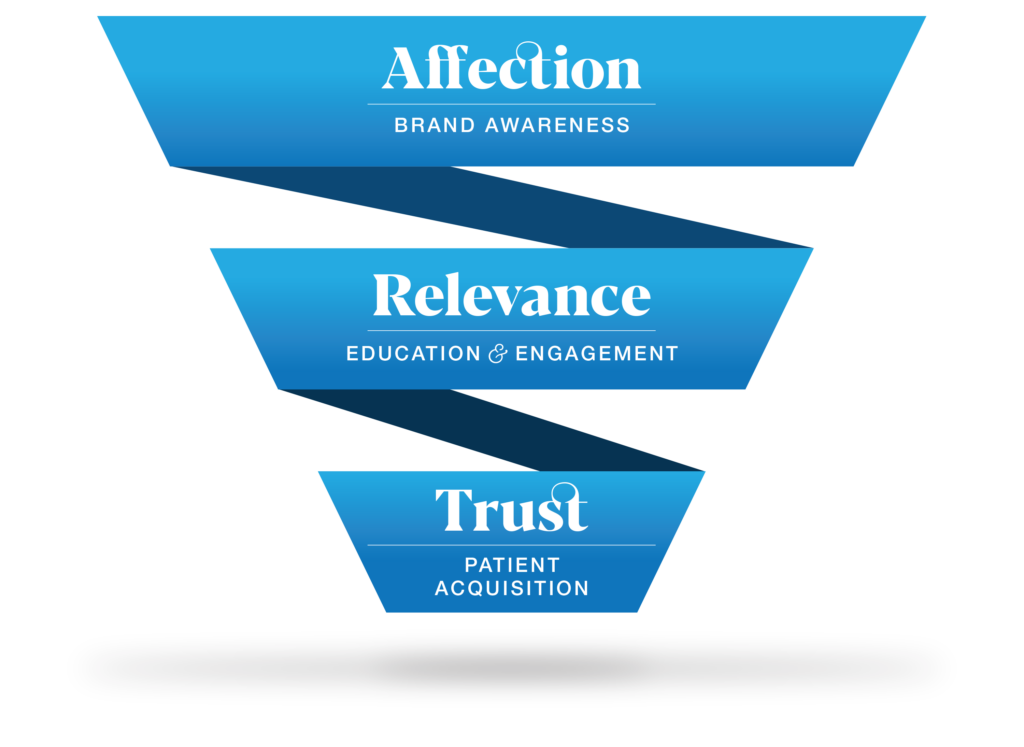If reshaping how consumers and patients think about your brand is a key objective for your organization, consider coming at this challenge from a new angle. Instead of changing what they think, focus on what they feel. We may assume our audiences are making rational, thoughtful decisions based on marketing RTB’s (reasons to believe), but they’re not.
Even in healthcare, you ask?
Especially in healthcare, we say.
Science shows that emotion decides, and logic validates—68% of buying decisions are made on gut feelings. In fact, researchers at Harvard found that 95% of buying decisions are subconscious. They’re made largely on emotion. Other studies have shown that patients who suffered damage to the parts of their brain responsible for emotions had a hard time making decisions.
So, if you’re not making emotional connections with consumers and patients, you’re missing the most important part of the story.
To build those emotional connections across the patient journey, we leverage A.R.T.: Affection, Relevance and Trust.

Building Affection and Awareness
We use the term affection because it means “a gentle feeling of fondness or liking.” At the awareness stage of the patient journey, that’s exactly what our goal should be—to set the stage for future engagement by establishing positive feelings (notice: feelings, not thoughts).
One way to do this is to demonstrate that your organization cares—and not just for its paying patient customers, but for the community at large, by making and showcasing community investments that are not immediately tied to your bottom line. One regional hospital lights its clocktower—changing the colors with the seasons – and creates a friendly beacon in the city skyline, a reminder that it’s more than an institution, it’s part of the community.
Can you make your audience smile? Even laugh? It may seem verboten in some circles for a formidable healthcare giant to show it has a sense of humor. After all, we deal with life-and-death decisions, don’t we? Yes, of course, but we’re all human and we could all use a reason to smile. (I may be simple, but if you can make me smile, I will find it hard not to like you.)
We tapped into that sense of humor for our work with Loretto, a Central New York non-profit leader in comprehensive healthcare services. Loretto’s spokesperson, a spunky septuagenarian named Loretta, embodies all the benefits of Loretto’s continuum of care and the freedom it gives its patients. So we created TV spots to match—highlighting the best of Loretto with some of our best one-liners.
Building Relevance and Engagement
Once we’ve built a degree of affection—that gentle feeling of fondness or liking—for our brand, it’s a lot easier to achieve engagement. We know that nationally, patient engagement levels are the lowest they’ve been in years. Whether due to the pandemic or just the increased level of marketplace noise, getting consumers to engage with healthcare organizations is tough.
This is where the R in A.R.T.—Relevance—comes in.
Using media channels that are relevant to your audience is critical, but that’s just the beginning. Creating relevant messaging and content for those channels is often the greater challenge.
So, what’s relevant? Put simply, content that people want to engage with. We know that there’s no lack of interest in health, wellness and care topics—you only have to look at Google search trends to see that. Though it may seem counterintuitive for, say, a heart institute to create content on heart health that helps people potentially prevent the need for heart surgery, that’s the right place to begin. Content on preventing heart disease is relevant to more people than content on minimally invasive heart valve surgery. There’s a time and a place for advanced care topics, but first bring people closer to your brand with accessible topics more likely to be relevant to them today.
UNC Health, North Carolina’s largest academic healthcare system, launched its YouTube Series “Things I’d Never Do” to engage with patients—both current and prospective—on social media. The series features emergent care doctors warning patients about risky behaviors, with one video topping 800,000 organic views, and an accompanying UNC Health Talk blog that uses UNC doctors, nurses, researchers and other providers as subject matter experts.
Building Trust and Patient Acquisition
The bad news for marketers is that trust can’t be built entirely through marketing. It’s very much dependent on the real experiences and interactions that patients have on their journey—from friendly phone interactions with the appointment scheduler to the demeanor of the triage nurse in the ER. We can lead consumers to trust us, but that trust can be derailed in a heartbeat.
I recently visited the ER with my husband and the experience was generally positive. We left with a printout confirming an appointment they’d made with a specialist a few days later. In short, our trust was high. When we showed up at the specialist’s office, they had no record of the appointment. Our trust in the quality of the systems behind our healthcare experience plummeted right there and then. We wondered: What other behind-the-scenes mistakes or disconnects might have occurred?
Just because you’ve acquired a patient, don’t assume you’ve acquired their trust. Trust is earned, and feelings of trust can ebb and flow as pluses and minuses in the patient experience accumulate.
Start with Affection, Add Relevance, Build Trust.
There’s science behind the A.R.T. of the patient journey, but there’s also a real art to it. When it comes to reshaping how consumers and patients feel about healthcare brands, we almost always place our bets on Affection. If I first have that “gentle feeling of fondness or liking” for you, I’ll be more receptive to your relevant content and messaging, and you’ll have every opportunity to build my trust.
